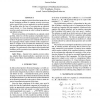Free Online Productivity Tools
i2Speak
i2Symbol
i2OCR
iTex2Img
iWeb2Print
iWeb2Shot
i2Type
iPdf2Split
iPdf2Merge
i2Bopomofo
i2Arabic
i2Style
i2Image
i2PDF
iLatex2Rtf
Sci2ools
ISBI
2007
IEEE
2007
IEEE
A Posteriori Error Estimation in Biomedical Imaging
We present an adaptive hybrid FEM/FDM method for an inverse scattering problem in scanning acoustic microscopy with a special focus on new application in medical imaging. The problem takes the form of reconstructing an unknown sound velocity c(x) from boundary displacement data measured in acoustic microscopy in order to obtain the pathological defects in bone. The inverse problem is formulated as an optimal control problem, where we solve the equations of optimality expressing stationarity of an associated Lagrangian by a quasi-Newton method. We present a posteriori error estimate for the error in the Lagrangian which couples residuals of the computed solution to weights of the reconstruction obtained by solving and associated linearized problem for the Hessian of the Lagrangian. The performance of the adaptive hybrid method and usefulness of the a posteriori error estimator are illustrated in numerical examples.
| Added | 03 Jun 2010 |
| Updated | 03 Jun 2010 |
| Type | Conference |
| Year | 2007 |
| Where | ISBI |
| Authors | Larisa Beilina |
Comments (0)

